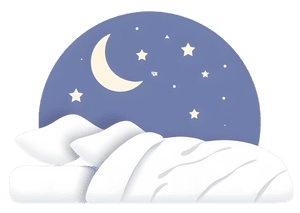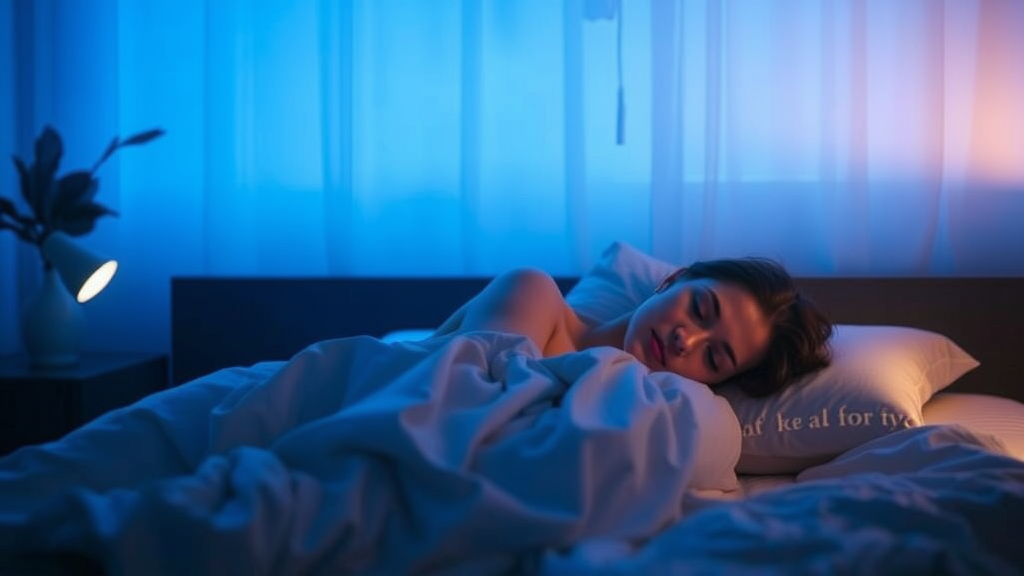Light plays a crucial role in regulating your body’s internal clock, also known as the circadian rhythm. Among various types of light, blue light has gained significant attention due to its impact on sleep patterns. Blue light is a high-energy visible (HEV) light emitted by the sun and artificial sources like digital screens, LED lights, and fluorescent bulbs. While it offers benefits during the day, exposure to blue light at night can disrupt your ability to fall asleep and stay asleep.
Understanding Blue Light
Blue light occupies a specific part of the visible light spectrum, ranging from 400 to 500 nanometers in wavelength. It is one of the shortest and highest-energy wavelengths, which makes it particularly effective at boosting alertness, improving reaction times, and elevating mood. During daylight hours, blue light helps regulate your circadian rhythm by signaling the brain to suppress melatonin production, the hormone responsible for making you feel sleepy. However, when exposed to blue light at night, this natural process gets disrupted.
How Does Blue Light Affect Melatonin Production?
Melatonin is often referred to as the “sleep hormone” because it tells your body when it’s time to wind down and prepare for rest. Specialized photoreceptor cells in your eyes called intrinsically photosensitive retinal ganglion cells (ipRGCs) are highly sensitive to blue light. When these cells detect blue light, they send signals to the suprachiasmatic nucleus (SCN), the part of your brain that controls the circadian rhythm. In response, the SCN instructs the pineal gland to reduce melatonin secretion. As a result, your body remains alert instead of transitioning into a relaxed state conducive to sleep.
The Impact on Sleep Quality
Exposure to blue light before bedtime not only delays the onset of sleep but also affects its overall quality. Studies have shown that individuals who spend extended periods staring at screens emitting blue light report difficulty falling asleep, frequent awakenings throughout the night, and reduced deep sleep phases. Deep sleep is essential for physical recovery, memory consolidation, and emotional well-being. By interfering with this critical phase, prolonged exposure to blue light can lead to chronic sleep deprivation, contributing to fatigue, irritability, and impaired cognitive function.
Here’s how blue light impacts different aspects of sleep:
- Sleep Onset Latency: The time it takes to fall asleep increases significantly after exposure to blue light.
- Duration of Sleep: Individuals may experience shorter sleep durations due to delayed melatonin release.
- Quality of Sleep: Reduced deep sleep and REM cycles lead to less restorative sleep.
Blue Light Sources in Daily Life
In today’s digital age, avoiding blue light entirely is nearly impossible. Common sources include smartphones, tablets, computers, televisions, and energy-efficient lighting solutions such as LEDs and CFLs. These devices emit substantial amounts of blue light, especially when used close to the face or for extended periods. For example, reading an eBook on a tablet before bed exposes your eyes to concentrated levels of blue light, making it harder to drift off.
A study comparing paper book readers versus e-reader users found that those using e-readers took longer to fall asleep, experienced less REM sleep, and felt more tired the next morning. This highlights the importance of being mindful about screen usage during evening hours.
Strategies to Minimize Blue Light Exposure
Fortunately, there are practical steps you can take to mitigate the negative effects of blue light on sleep:
- Limit Screen Time Before Bed: Try to avoid using electronic devices at least one hour before going to sleep. Instead, engage in relaxing activities such as reading a physical book or practicing mindfulness exercises.
- Use Night Mode Features: Many devices offer built-in settings that shift the color temperature of screens toward warmer tones after sunset. Enabling these features reduces blue light emission without compromising usability.
- Invest in Blue Light Blocking Glasses: Specialized eyewear designed to filter out blue light can be worn while using digital devices in the evening. These glasses help protect your eyes and maintain normal melatonin production.
- Create a Sleep-Friendly Environment: Dim overhead lights and opt for soft, warm lighting in your bedroom. Consider installing smart bulbs that automatically adjust their brightness and hue based on the time of day.
Scientific Evidence Supporting Blue Light’s Effects
Research continues to uncover the mechanisms through which blue light influences sleep. One notable study published in the Journal of Clinical Sleep Medicine examined participants’ sleep patterns under controlled conditions. Those exposed to bright blue light prior to bedtime exhibited suppressed melatonin levels and experienced poorer sleep quality compared to those exposed to dim red light. Another investigation revealed that wearing blue-light-blocking glasses improved sleep duration and efficiency in shift workers, demonstrating the potential benefits of targeted interventions.
Below is a table summarizing key findings from recent studies:
| Study Title | Key Findings | Implications |
|---|---|---|
| Impact of Evening Blue Light Exposure | Participants exposed to blue light showed delayed melatonin onset. | Reducing blue light exposure may improve sleep timing. |
| Effectiveness of Blue Light Filters | Glasses blocking blue light enhanced sleep quality in test subjects. | Wearing protective eyewear could be beneficial for nighttime device use. |
| Circadian Rhythm Regulation | Natural blue light exposure during the day supports better nighttime sleep. | Maximizing daytime blue light exposure might optimize circadian alignment. |
Promoting Healthy Sleep Habits
Beyond managing blue light exposure, adopting consistent sleep hygiene practices can further enhance your rest. Establish a regular sleep schedule, create a comfortable sleeping environment, and limit caffeine and alcohol intake close to bedtime. Combining these strategies with conscious efforts to minimize blue light interference can significantly improve your overall sleep health.
Ultimately, understanding the relationship between blue light and sleep empowers you to make informed decisions about your daily habits. By taking proactive measures to manage blue light exposure, you can safeguard your sleep quality and enjoy the numerous benefits associated with adequate rest. Remember, prioritizing sleep is an investment in your long-term health and well-being.
Practical tips to reduce blue light exposure before bedtime
Blue light has become a significant part of our daily lives, especially with the widespread use of digital devices. However, excessive exposure to blue light, particularly before bedtime, can disrupt your sleep patterns and affect your overall well-being. To ensure you get a restful night’s sleep, it’s essential to take practical steps to minimize your exposure to blue light in the evening. Here’s how you can achieve that:
Understanding Blue Light
Blue light is a type of high-energy visible (HEV) light emitted by the sun and artificial sources like smartphones, tablets, computers, and LED lights. While blue light plays a crucial role during the day by boosting alertness and regulating your circadian rhythm, overexposure at night can interfere with your body’s natural sleep-wake cycle.
When you’re exposed to blue light in the evening, it tricks your brain into thinking it’s still daytime. This suppresses the production of melatonin, the hormone responsible for inducing sleep. As a result, you may find it harder to fall asleep or stay asleep throughout the night.
Practical Ways to Reduce Blue Light Exposure
To help you maintain a healthy sleep routine, here are some effective strategies to reduce blue light exposure before bedtime:
- Limit Screen Time: Try to avoid using electronic devices at least one to two hours before going to bed. This gives your body enough time to start producing melatonin naturally.
- Enable Night Mode Settings: Most modern devices come equipped with night mode or blue light filter settings. These features adjust the screen’s color temperature, reducing blue light emission and making it easier on your eyes.
- Use Blue Light Blocking Glasses: If you must use your devices before bed, consider wearing glasses specifically designed to block blue light. These lenses can significantly reduce the amount of blue light reaching your eyes.
In addition to these methods, there are several other approaches you can adopt to further protect yourself from the negative effects of blue light.
Create a Relaxing Environment
Your bedroom should be a sanctuary for rest and relaxation. Dim the lights and opt for warm, yellow-toned lighting instead of bright white or blue lights. This change in ambiance signals to your brain that it’s time to wind down.
If possible, replace any LED bulbs in your bedroom with incandescent ones, as they emit less blue light. Alternatively, invest in smart lighting systems that allow you to customize the color and intensity of the light based on the time of day.
Establish a Consistent Sleep Routine
A consistent sleep schedule helps regulate your internal clock and improves the quality of your sleep. Go to bed and wake up at the same time every day, even on weekends. Over time, this consistency will make it easier for your body to prepare for sleep without interference from external factors like blue light.
Engage in calming activities before bed, such as reading a physical book, practicing meditation, or taking a warm bath. Avoid stimulating tasks that require intense focus or prolonged screen usage.
Adjust Your Device Usage
While completely avoiding screens might not always be feasible, you can still modify your device habits to minimize blue light exposure. For instance, switch to text-based apps or voice commands when possible. Use e-readers with e-ink displays, which do not emit blue light, for nighttime reading.
Additionally, keep your devices out of the bedroom if you can. Having them nearby tempts you to check notifications or browse social media, increasing your chances of encountering unnecessary blue light exposure.
Evaluate Your Surroundings
External sources of blue light, such as streetlights or indoor lighting, can also impact your sleep. Consider installing blackout curtains or blinds to block outside light pollution. Similarly, cover any glowing electronics in your room, such as clocks or chargers, to create a darker environment conducive to sleep.
| Tip | Description |
|---|---|
| Dim Lights | Reduce brightness levels to promote relaxation. |
| Remove Screens | Keep devices away from the bedroom to prevent distractions. |
| Use Warm Lighting | Select bulbs with lower blue light emissions for better sleep hygiene. |
Remember, small changes in your daily habits can lead to significant improvements in your sleep quality. By actively managing your blue light exposure, you’re taking an important step toward maintaining good health and ensuring restorative sleep.
Pay attention to how different strategies work for you personally. Everyone’s sensitivity to blue light varies, so experiment with various techniques until you find what works best for your lifestyle and needs. With dedication and persistence, you’ll soon enjoy deeper, more restful nights of sleep.
Key Takeaway:
Blue light, emitted by digital screens and other artificial light sources, plays a significant role in disrupting sleep patterns. Understanding how blue light affects sleep is crucial for maintaining healthy rest cycles and overall well-being. This article highlights the science behind blue light’s impact on sleep and provides practical tips to help you reduce its effects before bedtime.
Firstly, blue light exposure interferes with your body’s natural production of melatonin, the hormone responsible for regulating sleep-wake cycles. During the day, blue light helps boost alertness and mood, which is beneficial. However, when exposed to it at night, especially through smartphones, tablets, or computer screens, it tricks your brain into thinking it’s still daytime. As a result, melatonin production decreases, making it harder to fall asleep and stay asleep. Over time, this can lead to chronic sleep deprivation, affecting both physical health and mental clarity.
To combat these issues, implementing simple yet effective strategies can significantly improve your sleep quality. One of the easiest ways to reduce blue light exposure is by setting a “screen-free” period before bed—ideally one to two hours. Instead of scrolling through social media or watching videos late into the evening, engage in relaxing activities like reading a book (preferably printed), meditating, or journaling. These alternatives not only limit blue light but also prepare your mind for rest.
If avoiding screens entirely isn’t feasible, consider using blue light filtering glasses or enabling night mode settings on your devices. Many modern gadgets offer features that reduce blue light emission after sunset, helping to preserve melatonin levels. Additionally, dimming overhead lights and opting for warmer-toned bulbs in your bedroom can further minimize disruptive lighting.
Ultimately, prioritizing good sleep hygiene involves being mindful of your environment and habits. By recognizing how blue light affects sleep and taking proactive steps to mitigate its influence, you can enjoy deeper, more restorative sleep. Remember, small changes add up over time, leading to better energy levels, improved focus, and enhanced overall wellness. So take control of your nighttime routine today and give yourself the gift of quality rest!
Conclusion
Understanding how blue light affects sleep is a crucial step toward improving your overall well-being. By now, you’ve learned that exposure to blue light, especially from screens like smartphones, tablets, and computers, can interfere with your body’s production of melatonin—the hormone responsible for regulating sleep. This disruption can make it harder for you to fall asleep and stay asleep, leading to poor-quality rest and potential long-term health effects.
The good news is that there are practical steps you can take to minimize blue light exposure before bedtime. Simple changes, such as setting a screen-free hour before bed, using blue light filters on devices, or wearing blue-light-blocking glasses, can go a long way in helping you prepare for better sleep. These strategies empower you to take control of your environment and create healthier habits that support your natural sleep cycle.
Remember, sleep is essential for physical and mental recovery, so prioritizing it should be a top goal. By being mindful of your blue light consumption and making small adjustments to your routine, you can enjoy more restful nights and feel more energized during the day. Start implementing these tips tonight and see how they positively impact your sleep quality. Your body—and mind—will thank you!


